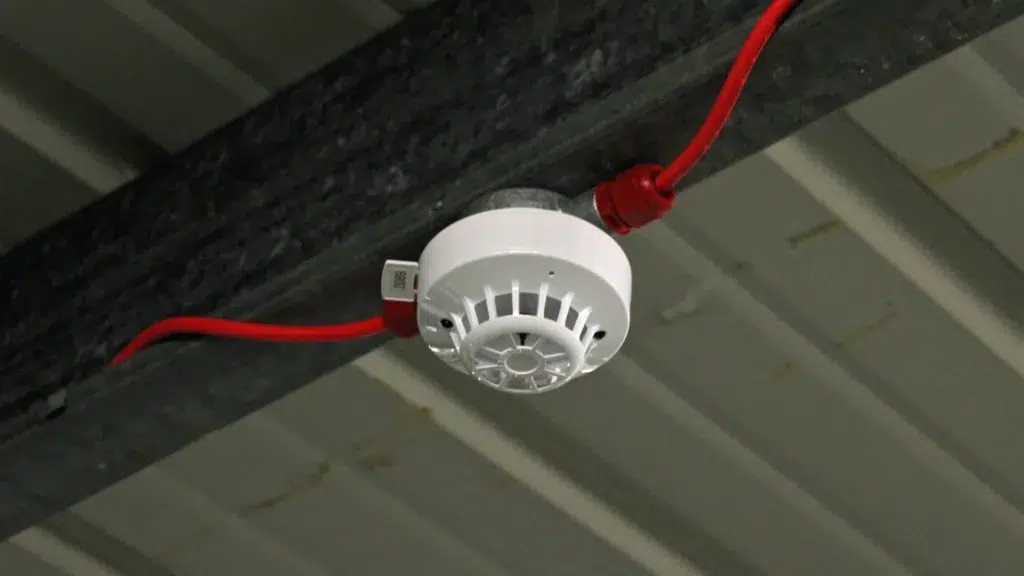Fire alarm systems come in various types, each designed to detect and alert occupants to a fire in different ways. The main types include conventional, addressable, wireless, and two-wire fire alarm systems. Each system has its own advantages and is suited for specific building sizes and requirements.
Fire alarm systems play a crucial role in protecting lives and property by detecting fires early and providing immediate alerts. Different fire alarm systems cater to various needs, ranging from small residential setups to large commercial buildings. These systems use various initiating devices, such as smoke detectors, heat sensors, and manual pull stations, to detect fire hazards efficiently.
Key Takeaways:
- Fire alarm systems come in different types: conventional, addressable, wireless, and two-wire.
- Conventional fire alarm systems are zone-based and cost-effective.
- Addressable fire alarm systems provide precise location details.
- Wireless fire alarm systems offer flexibility and quick installation.
- Two-wire fire alarm systems enhance efficiency by reducing wiring needs.
- Fire alarm initiating devices can be manual or automatic.
- Fire detectors include ionization smoke detectors, photoelectric smoke detectors, heat detectors, and hybrid detectors.
- Choosing the right fire alarm system depends on building size, regulatory requirements, and budget.

Types of Fire Alarm Systems
Conventional Fire Alarm Systems
Conventional fire alarm systems divide a building into zones, with each zone wired to a dedicated circuit in the fire alarm control panel. When an alarm is triggered, the panel indicates the affected zone, requiring manual investigation to locate the fire source. These systems are cost-effective and best suited for small to medium-sized buildings.
Pros:
- Affordable and easy to install
- Ideal for small spaces
Cons:
- Limited precision in pinpointing fire locations
- Requires manual investigation
Addressable Fire Alarm Systems
Addressable fire alarm systems use unique digital addresses for each device, allowing precise identification of the triggered alarm. These systems are commonly used in large facilities where quick identification and response are critical.
Pros:
- Pinpoints the exact location of a fire
- Reduces response time for firefighters
Cons:
- Higher initial cost
- Requires professional installation
Wireless Fire Alarm Systems
Wireless fire alarm systems eliminate the need for extensive wiring, making them suitable for buildings where wiring is impractical or costly. These systems use radio signals to connect fire detectors, alarms, and control panels.
Pros:
- Quick and easy installation
- Suitable for historic buildings or temporary setups
Cons:
- Requires battery maintenance
- Higher cost than conventional systems
Two-Wire Fire Alarm Systems
Two-wire fire alarm systems operate similarly to conventional systems but allow detectors, call points, and alarm devices to share the same wiring. This reduces installation complexity and enhances efficiency.
Pros:
- Reduces installation time and costs
- Suitable for smaller buildings
Cons:
- Higher initial cost compared to conventional systems
- Limited scalability for large buildings
Types of Fire Alarm Initiating Devices
Manual Initiating Devices
Manual pull stations require a person to activate the alarm physically. These are commonly found in commercial buildings and schools.
Automatic Initiating Devices
These devices detect fire hazards and activate the alarm automatically. Examples include:
- Smoke Detectors – Detect smoke particles in the air.
- Heat Detectors – Sense a rise in temperature.
- Fire Sprinklers – Activate upon heat detection.
Types of Fire Detectors
Ionization Smoke Detectors
Ionization smoke detectors detect fast-burning fires by sensing disruptions in an electrical current caused by smoke.
Photoelectric Smoke Detectors
These detectors use a laser beam to detect smoke, making them effective for detecting slow-burning fires.
Heat Detectors
Heat detectors respond to significant temperature changes, making them suitable for areas prone to false alarms due to dust or steam.
Combined Ionization and Photoelectric Detectors
These hybrid detectors offer dual detection methods, improving overall fire detection accuracy.
Additional Information About Fire Alarm Systems
- Fire alarm systems must comply with local safety codes and regulations.
- Regular maintenance and testing are crucial to ensure reliability.
- Modern fire alarm systems integrate with building management systems for enhanced safety.
- Battery backup systems ensure fire alarms function during power outages.
Frequently Asked Questions
What is the best fire alarm system for a large building?
Addressable fire alarm systems are best suited for large buildings due to their precise location tracking and scalability.
How often should fire alarm systems be tested?
Fire alarm systems should be tested at least once a month, with a professional inspection conducted annually.
Can fire alarms work without electricity?
Yes, most fire alarm systems have battery backups to ensure functionality during power failures.
Choosing the Right Fire Alarm System
Selecting the right fire alarm system depends on various factors, including building size, budget, and specific safety requirements. Whether opting for a conventional, addressable, wireless, or two-wire system, regular maintenance and compliance with safety regulations are key to ensuring optimal fire protection. Investing in a reliable fire alarm system enhances safety, minimizes property damage, and saves lives.and other structures by releasing a chemical agent that extinguishes the flames. They are often used in areas where water-based systems, such as sprinklers, are not appropriate.









